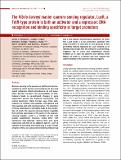| dc.contributor.author | Pompeani, Audra J | |
| dc.contributor.author | Irgon, Joseph J | |
| dc.contributor.author | Berger, Michael F | |
| dc.contributor.author | Bulyk, Martha Leonia | |
| dc.contributor.author | Wingreen, Ned S | |
| dc.contributor.author | Bassler, Bonnie L | |
| dc.date.accessioned | 2011-03-19T06:30:14Z | |
| dc.date.issued | 2008 | |
| dc.identifier.citation | Pompeani, Audra J., Joseph J. Irgon, Michael F. Berger, Martha L. Bulyk, Ned S. Wingreen, and Bonnie L. Bassler. 2008. The Vibrio harveyi master quorum-sensing regulator, LuxR, a TetR-type protein is both an activator and a repressor: DNA recognition and binding specificity at target promoters. Molecular Microbiology 70(1): 76-88. | en_US |
| dc.identifier.issn | 0950-382X | en_US |
| dc.identifier.uri | http://nrs.harvard.edu/urn-3:HUL.InstRepos:4745731 | |
| dc.description.abstract | Quorum sensing is the process of cell-to-cell communication by which bacteria communicate via secreted signal molecules called autoinducers. As cell population density increases, the accumulation of autoinducers leads to co-ordinated changes in gene expression across the bacterial community. The marine bacterium, Vibrio harveyi, uses three autoinducers to achieve intra-species, intra-genera and inter-species cell–cell communication. The detection of these autoinducers ultimately leads to the production of LuxR, the quorum-sensing master regulator that controls expression of the genes in the quorum-sensing regulon. LuxR is a member of the TetR protein superfamily; however, unlike other TetR repressors that typically repress their own gene expression and that of an adjacent operon, LuxR is capable of activating and repressing a large number of genes. Here, we used protein binding microarrays and a two-layered bioinformatics approach to show that LuxR binds a 21 bp consensus operator with dyad symmetry. In vitro and in vivo analyses of two promoters directly regulated by LuxR allowed us to identify those bases that are critical for LuxR binding. Together, the in silico and biochemical results enabled us to scan the genome and identify novel targets of LuxR in V. harveyi and thus expand the understanding of the quorum-sensing regulon. | en_US |
| dc.language.iso | en_US | en_US |
| dc.publisher | Blackwell Publishing Ltd | en_US |
| dc.relation.isversionof | doi:10.1111/j.1365-2958.2008.06389.x | en_US |
| dc.relation.hasversion | http://www.ncbi.nlm.nih.gov/pmc/articles/PMC2628434/pdf/ | en_US |
| dash.license | LAA | |
| dc.title | The Vibrio harveyi Master Quorum-sensing Regulator, LuxR, a TetR-type Protein is Both an Activator and a Repressor: DNA Recognition and Binding Specificity at Target Promoters | en_US |
| dc.type | Journal Article | en_US |
| dc.description.version | Version of Record | en_US |
| dc.relation.journal | Molecular Microbiology | en_US |
| dash.depositing.author | Bulyk, Martha Leonia | |
| dc.date.available | 2011-03-19T06:30:14Z | |
| dash.affiliation.other | HMS^Pathology | en_US |
| dash.affiliation.other | HMS^Medicine-Brigham and Women's Hospital | en_US |
| dc.identifier.doi | 10.1111/j.1365-2958.2008.06389.x | * |
| dash.contributor.affiliated | Bulyk, Martha | |


